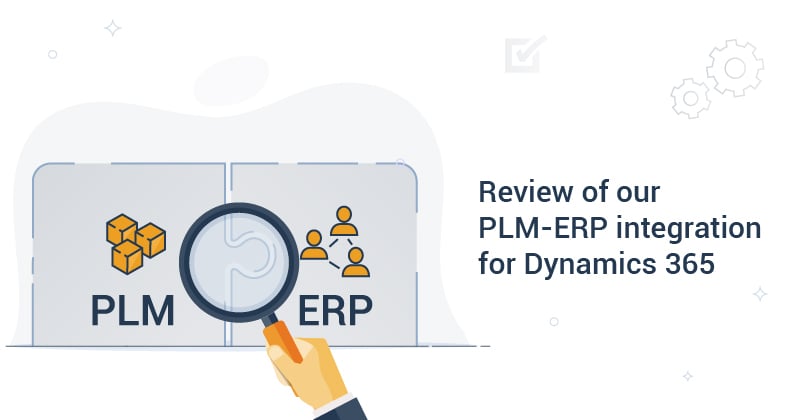PLM-ERP integration can help streamline communications among your engineering and manufacturing teams. Companies looking to integrate their PLM and ERP systems must consider several factors before deciding on the solution that fits their business needs.
If you are a business using Microsoft Dynamics 365 as an ERP or are exploring the option of moving to D365, you might be thinking of a standard integration solution that connects your PLM to D365 ERP.
With nearly two decades of experience in the manufacturing industry, we offer PLM-ERP integrations for D365 ERP and have empowered countless companies to transform their operational efficiency.
In this article, we will share a 360-degree view of our solution's features, benefits, pricing, and limitations so you can make an informed decision about whether it is a good fit for your organization.
Note: We offer PLM integrations for Dynamics AX 2012 as well. However, in this article, we will be discussing the PLM integration framework for D365 F&SCM/F&O.
Buckle up to discover the following on this journey:
- What is the PLM-ERP integration solution?
- Features of the PLM-ERP integration for D365 F&SCM
- Benefits of using our solution
- Pricing and cost of PLM-ERP integration for D365 F&SCM
- Limitations of the integration solution
- Who is the PLM-ERP integration a good fit for?
What is To-Increase’s PLM-ERP integration solution?
PLM-ERP integration for Microsoft Dynamics 365 Finance and Supply Chain Management is an intuitive, configurable integration solution that connects third-party PLM, PDM, and CAD systems with the D365 F&SCM ERP system.
Using our solution, you can ensure a seamless data flow between your engineering and manufacturing systems and enable quicker time-to-market. With all your engineering and manufacturing information stored in one location, you always have the correct data at the right time to complete production efficiently.
Features of our PLM-ERP integration solution
1. Automated data transfer
Product data and bills of materials (BOMs) are transferred through a structured and automated process from PLM to ERP, reducing errors and delays. You can automatically transfer plenty of product data such as revision data, multi-level and single-level BOMs, attributes, status information, etc.
2. Staging journal
Data from the PLM system is validated and transformed in the staging journal before being released to the ERP. This ensures data quality and guarantees your data is correctly mapped to the ERP.
You are notified if there's a mismatch or error in any product data via the 'error notification.'
3. Unified data view and storage
With the PLM-ERP integration solution, you have one location to store and access all product-related data. You can work with a single entity or multiple legal entities and access all product-related data in a single source of truth.
4. Ownership and governance of data
The PLM-ERP integration solution safeguards engineering data in ERP and prevents deleting or overriding of operational data during any PLM updates through the ‘trigger managed processes.’
The integration recognizes any change within product versions coming from the PLM system and automatically updates data in the ERP without changing any other product fields, thus maintaining data ownership and simplifying product change management.
5. Access logistical ERP data within PLM
With our newly released functionality, product logistic insights, you can easily access ERP data from the PLM system.
Engineers and designers using the PLM or PDM system can retrieve logistical and operational information residing in the ERP with the click of a button — saving time, training effort, and ERP license costs.
The above discussed are the feature highlights for our solution. Read this article to know more about our solution features.
Benefits of our PLM-ERP integration solution
1. Embedded within D365 ERP
The integration solution is embedded within D365 ERP and follows the D365 business logic, allowing maximum flexibility to connect to external PLM or engineering systems.
If you are an existing user of Microsoft Dynamics 365 ERP, you can easily implement our PLM integration solution that’s fully aligned with the Microsoft ecosystem.
2. Highly adaptable
Our PLM-ERP integration can easily be adapted to connect to any PLM, PDM, CAD, or MDM systems to Dynamics 365 ERP. Additionally, we can connect a combination of engineering systems to the ERP. For instance, let's say you use two PLM systems and one CAD system; we can integrate all three systems with the D365 ERP.
3. Quick time to value
While the final implementation time varies based on many factors, the implementation duration can be as short as two weeks. The solution is easy to set up, and your PLM and ERP systems will be integrated with minimal intrusion on operations supported by in-house experts with over ten years of implementation experience. You can explore the implementation process we follow here.
With a strong global partner network, we can provide you with in-person or remote implementations, irrespective of your business’s location.
4. Enhanced collaboration
As the solution creates a seamless, real-time connection between the engineering and manufacturing worlds, communication among different business units becomes smooth.
The integration fosters collaboration through automated data transfer, working in tandem, and feedback among teams, resulting in improved product quality.
5. Supports version management
Our solution works in combination with engineering change management (ECM), a prerequisite to the PLM integration solution. The solution extends the version management of ECM and provides increased insight into version updates during the different lifecycle stages of the product.
6. Low development effort
As a flexible solution, the PLM-ERP integration framework is based on an intuitive, user-friendly approach. The integration can easily map PLM data to the data fields in Dynamics 365 with a simple configuration, sparing the need to rely on heavy programming.
It is more valuable for your company to buy the PLM-ERP integration solution rather than build it from scratch.
7. Reduced costs and effort
In an integrated environment, with manual intervention minimalized, your product data moves directly from PLM to ERP, reducing the duplication of work and decreasing the scope of errors.
With complete visibility of accurate data across your supply chain, you retain consistency with one source of truth — saving time, effort, and unwanted expenses.
8. Easy maintenance
As a future-proof solution, it has been designed by industry experts who have included features based on their deep expertise to address business needs comprehensively. The PLM-ERP integration solution is certified for Microsoft Dynamics and follows the monthly upgrade policy of Microsoft, ensuring your solution always runs on the latest version.
What is the price of PLM-ERP integration for D365 F&SCM?
The final cost of the integration solution depends on the nature of your business and several other variables. The licensing cost for our PLM-ERP integration solution is based on the size of your company. To define the size of your company, we take the number of users you require for your business as a calculation unit. The total licensing cost combines a base price and the price per user per month.
The monthly base price of our solution is €1000 and includes a certain number of support tickets. For calculating the monthly license cost related to the size of your company, we calculate the price for the first 50 user licenses at €20 per user. The price for 51 users and beyond is €10 per user.
The cost of the software services could be anywhere between €4,000 to €14,000.
To get the pricing in USD, carry out a conversion based on the current exchange rate. Read this article to know about our pricing in detail.
What are the limitations of our PLM-ERP integration solution?
1. Integration with a single ERP
Since our PLM-ERP integration solution is built within Microsoft D365, the integration framework cannot be configured for any other ERP apart from D365 F&SCM. We also offer configurable PLM integrations for Dynamics AX 2012.
We do not provide out-of-the-box integrations for D365 business central or other ERP systems.
2. Prerequisite of ECM
As mentioned earlier, our integration solution works with ECM – you must have ECM set up in D365 to use our PLM-ERP integration solution. Since we leverage ECM, our primary focus is the manufacturing industry, and we cannot support the process industry or integrations with building information management (BIM) for the construction industry.
Being experts on ECM (previously: product engineering), we can assist you with its setup and offer support in implementing the solution. If you are on Dynamics AX 2012, you need Product Engineering to use our solution.
3. Support of eBOMs import
Our integration solution can easily import mBOM (manufacturing bill of materials) from the PLM to ERP. However, the solution does not support importing eBOMS (engineering bill of materials). If you’d like to import eBOMS, it can be done via a third party or by converting the eBOM to an mBOM in the PLM system.
4. Feedback into PLM
We offer logistical data to be sent to the PLM via web services from the ERP, such as on-hand inventory, vendor details, open transactions, and other cost information. However, the option of sending change orders to the PLM (engineering change orders and engineering change requests) is not available out of the box but is configurable.
Who is the PLM-ERP integration a good fit for?
The PLM-ERP integration solution is a good fit for any business that is:
- Using Microsoft Dynamics 365 F&SCM
- Using Dynamics AX 2012
- Considering migrating to the ERP mentioned above
- Implementing ECM in D365 F&SCM
However, if you do not use Microsoft’s Dynamics 365 ERP, our integration solution will not be the best fit for you.
Apart from the configurable PLM-ERP integration discussed in this article, we offer out-of-the-box PLM integrations for Siemens Teamcenter and PTC Windchill. And provide PLM integrations with 3DX Dassault, Ansys, and other PLM or engineering or designing systems such as PDM and CAD.
If you want a robust, configurable, and easy-to-use solution with no coding hassles and a quick implementation time, our PLM-ERP integration might be just what you’re looking for. You could explore more about our PLM-ERP integration solution by downloading the solution factsheet.
If you have any questions or are interested in learning more about our PLM-ERP integration solution, feel free to contact our experts. We’d love to talk with you and guide you on the best approach to integrate your PLM and ERP system.




